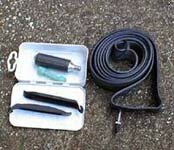Many people are put off from riding reasonable distances due to the possibility of pu nctures. To others, punctures are the last thing in the world they think about as they go zooming out into - the wilderness. The latter often face the long walk home, such a shame when with a small amount of pre-ride preparation the walk could have been prevented.
nctures. To others, punctures are the last thing in the world they think about as they go zooming out into - the wilderness. The latter often face the long walk home, such a shame when with a small amount of pre-ride preparation the walk could have been prevented.
With a bit of practice most people will be able to "repair" at least one puncture during a ride, more if you are very prepared. They say you should never leave home without a certain plastic card - a cyclist should never leave home without at least one spare inner tube, tyre levers and a means of reinflating a tyre. These can easily be stored in a small pouch under your saddle or even a bum bag (never understood why they call them that when you wear them at the front).
To show how easy the job is. At the risk of being sexist we asked a lady cyclist to perform the task for us. And we asked her to do it with the rear wheel, on her bike which is a fully equipped Dawes World Tour and without the aid of a safety net and nail-file.